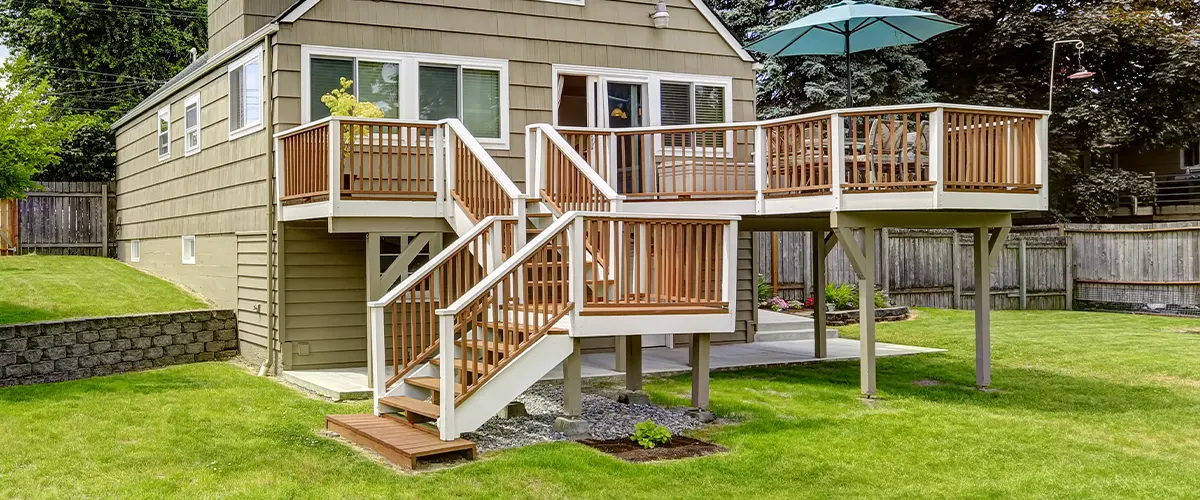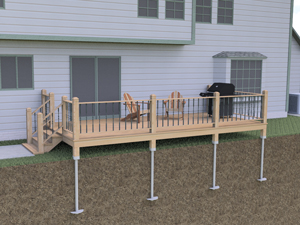Structure from scratch: The Ultimate Guide to Creating and Installing Deck Footings
Wiki Article
Choosing the Right Deck Footings for Stability and Durability
When it involves constructing a deck, among one of the most important choices you will certainly make is choosing the appropriate grounds for stability and toughness. The durability and safety and security of your deck depend heavily on the type of footings you choose, as they provide the vital assistance and stability to endure the examination of time. With a myriad of options available, it can be frustrating to figure out which grounds are best matched for your details needs. In this conversation, we will certainly check out the different sorts of deck footings, consider the crucial factors to weigh when deciding, and look into the benefits and drawbacks of different options. By the end, you will certainly have a clearer understanding of the selections available and be much better equipped to make a notified decision for your deck job.Kinds Of Deck Grounds
There are a number of sorts of deck footings that can be made use of, each offering unique benefits and considerations. One usual sort of footing is the concrete pier footing. These grounds include a round hole filled with concrete, which supplies a strong foundation for the deck posts. Concrete pier grounds are reasonably very easy to install and use outstanding stability, making them a popular choice for many deck projects.One more kind of footing is the helical heap ground. Helical heaps are steel shafts with helical plates connected to them. These grounds are installed by screwing them into the ground, which produces a safe and secure structure for the deck. Helical stack grounds are suitable for areas with difficult dirt problems, as they can be mounted in virtually any kind of soil. They also enable easy modification and progressing of the deck if needed.
Additionally, some home builders select precast concrete grounds. These grounds are made from resilient concrete and come in different shapes and dimensions to accommodate different deck designs. Precast concrete footings are hassle-free to set up and supply a steady base for the deck framework.
Ultimately, one more option is the post-in-anchor footing system. This kind of footing entails driving a metal support right into the ground and attaching it to the deck article. It uses adaptability in terms of placing the deck blog posts and appropriates for decks with light-weight frameworks.
When selecting the appropriate kind of deck footing, it is necessary to take into consideration aspects such as soil problems, deck lots, and neighborhood building regulations (Deck Footings). Consulting with a professional service provider or structural designer can assist ensure the suitable ground is picked for a secure and risk-free deck
Factors to Think About When Choosing Footings
When selecting the appropriate footings for a deck, it is critical to thoroughly consider various variables such as dirt problems, deck tons, and adherence to neighborhood structure codes. These elements play a significant function in ensuring the stability and longevity of the deck structure.The type of dirt on which the deck will be built figures out the type of grounds required. On the various other hand, decks developed on clay or expansive soils may call for footings that can fit the dirt's propensity to expand and contract.
Another important variable is the deck tons. The weight of the deck, consisting of the materials made use of and any type of potential real-time loads such as furnishings or gatherings, need to be taken into account when picking footings. The grounds have to be designed to bear the weight of the deck and distribute it uniformly to stop any architectural concerns or failings.
Finally, adherence to regional building codes is extremely important. Building ordinance vary from region to area, and it is necessary to abide by the certain demands established by the local authorities. Deck Footings. These codes make sure that the deck is constructed safely and satisfies the essential criteria for structural integrity and load-bearing capacity
Concrete Grounds: Cons and pros

Concrete footings provide a number of advantages and disadvantages when used as the foundation for a deck. On the favorable side, concrete footings provide exceptional security and toughness.
Another advantage of concrete grounds is their adaptability. They can be poured into different forms and dimensions to accommodate different deck layouts and arrangements. Concrete grounds can be tailored to fit the certain demands and demands of the deck framework.
However, there are additionally some disadvantages to making use of concrete grounds. One significant downside is the price visit homepage and labor entailed in their installation. Concrete grounds call for excavation and often require the assistance of heavy machinery. This can boost the total cost of the deck project and might need expert assistance.

Helical Piers Vs. Sonotubes: Which Is Better?
In taking into consideration the structure alternatives for a deck, the comparison between helical piers and sonotubes is essential in determining the exceptional option. They are twisted right into the ground making use of hydraulic equipment, supplying a durable and secure foundation for the deck.When it pertains to security and sturdiness, helical piers have the top hand. The helical plates on the piers create a solid hold with the soil, preventing any type of movement or moving of the deck. This is specifically valuable in locations with unstable or shifting soil conditions. Sonotubes, on the other hand, rely entirely on the concrete filling for security, which might not supply the very same degree of toughness and resistance.
In terms of installment, helical piers are fairly less complicated and faster to set up compared to sonotubes. The hydraulic equipment made use of to twist the piers right into the ground ensures a effective and quick process. Sonotubes, on the various other hand, call for digging openings and putting concrete, which can be taxing and labor-intensive.
Furthermore, helical piers are an even more versatile option. They can be made use of in various soil problems and can be readjusted or reinforced if required. Sonotubes, on the other hand, might need additional support, such as rebar, in certain dirt conditions or areas with high lots requirements.
Picking the Right Footings for Your Deck's Dimensions
For optimum structural honesty, it is essential to very carefully choose the appropriate footings that align with the measurements of your deck. The dimensions of your deck, including its size, size, and height, play a substantial duty in determining the type and dimension of footings needed.When selecting grounds for your deck, it is necessary to take into consideration the load-bearing ability of the dirt. The weight of the deck, integrated with the weight of any type of furniture or people on it, exerts a substantial pressure on the grounds (Deck Footings). It is crucial to choose grounds that can sufficiently support this weight without changing or sinking over time.
Larger decks with better dimensions need larger footings to supply enough security and support. The shape of the grounds, whether they are square or rounded, depends on the style visit their website and design of the deck.
Verdict
In verdict, picking the right deck footings is crucial for guaranteeing security and durability. Elements such as the type of grounds, the deck's dimensions, and the pros and disadvantages of different alternatives ought to be considered.These footings are composed of a cylindrical hole filled with concrete, which gives a strong foundation for the deck articles. Concrete pier grounds are relatively simple to set up and use superb security, making them a prominent selection for several deck projects.
Precast concrete grounds are convenient to set website here up and offer a steady base for the deck framework.
It provides adaptability in terms of positioning the deck messages and is appropriate for decks with lightweight structures.
Concrete grounds supply numerous benefits and downsides when used as the structure for a deck.
Report this wiki page